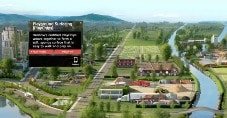Bioswales and Rain Gardens
Engineering Nature for Stormwater Management
As urban landscapes are expanding and changing, the challenge of managing stormwater runoff is becoming increasingly vital. Bioswales and Rain Gardens are innovative solutions that mimic natural processes to mitigate flooding and filter pollutants. While those two systems are often mentioned together, they do have distinct roles and applications within stormwater management. Let’s explore the science behind how they work, their differences and what factors can affect their efficiency.
Bioswales
Bioswales are shallow, sloped channels designed to direct and slow the flow of stormwater, allowing it to gradually infiltrate the soil. You may more commonly know these as ditches. The important distinction here is that they are intentionally vegetated with seeded and volunteer plants. By intercepting water runoff from places such as roads, sidewalks or parking lots, Bioswales reduce peak flow rates, helping to mitigate flash floods and minimize erosion. The vegetation and soil within the Bioswale work together to filter out sediments and pollutants, such as heavy metals, oils and chemicals before the water re-enters the ground and continues into the stormwater system.
The design of Bioswales typically includes layers of soils, gravel or sand and vegetation that enhance infiltration rates and maximize the removal of pollutants. For them to work best, Bioswales must be properly graded and sized based on local rainfall patterns and expected water volumes. So, a Bioswale designed in the Pacific Northwest would be much different than one designed in a dryer environment.
Rain Gardens
Contrasting Bioswales, rain gardens are shallow depressions which are designed specifically to capture and retain rainwater, promoting slow infiltration into the ground. Rain gardens are best to manage flow over localized areas, so they are often installed near buildings, driveways or areas where stormwater collects. The goal here is to allow water to percolate slowly through the soil, reducing the burden on stormwater infrastructure while helping eliminate pollutants.
Rain gardens often hold water for short periods after a storm, which gives it time to soak into the ground while filtering it. Over time, they can significantly reduce the volume of runoff that reaches storm drains which helps to prevent urban flooding.
Key Differences
While Bioswales and rain gardens share similar goals, they differ in terms of structure, function and scale. When one is choosing which would work best you must first decide which function you would like for it to have. Here are a few key differences to consider:
- Flow vs. Retention: Bioswales are designed to channel and support the flow of water across a sloped surface while rain gardens focus on water retention into a confined area.
- Scale of Implementation: Bioswales are typically used in large-scale projects such as roadways or parking lots while rain gardens are more common in residential or small-scale urban landscapes.
- Design and Grading: Bioswales require engineered grading to ensure proper flow while rain gardens are typically concerned with creating a low point to collect and hold water temporarily.
It’s important to note that soil can also play a critical role in the functionality of a Bioswale or rain garden. After deciding what the function is you are trying to serve, you will want to then look at a soil that will serve this purpose. With a Bioswale you will want to consider a soil that allows water to flow more easily, while with a rain garden you will want to consider a soil that will assist in water retention.
Plant selection also plays an important role in the creation of both Bioswales and rain gardens. You will want to consider clear grasses or vegetation for Bioswales. You can get a bit more creative with the plants you choose when creating a rain garden, but you’ll want to make sure that they are plants that can sustain a large amount of water for a period of time. Both situations require plants that will be more water tolerant. When moving towards the realm of rain gardens, you will also need to decide whether or not the rain garden is there as an aesthetic piece of your garden or if it is just there to serve its purpose. While deciding on this, also keep in mind how much maintenance will have to be placed into the plants, and whether or not this is constructive to the ultimate purpose of the rain garden or Bioswale.
Bioswales and rain gardens represent a powerful, nature-based approach to managing stormwater runoff in both urban and suburban environments. By leveraging the natural filtration power of plants, soil and microbial activity, these systems provide effective solutions for flood mitigation, water quality improvement and overall beautification of urban areas.
Understanding the science behind Bioswales and rain gardens – and the roles that soil type, plant selection and design play in their success – can help guide their implementation in a wide variety of settings, from residential backyards to large-scale urban projects. As climate change intensifies weather patterns and stormwater challenges, Bioswales and rain gardens are set to play an increasingly vital role in sustainable urban planning.







